 |
| Module 3: Toxicology - Section 5: An Approach To Managing Case Problems In Occupational Medicine |
| TOX 5.1: Overview |
 |
| Module 3: Toxicology - Section 5: An Approach To Managing Case Problems In Occupational Medicine |
| TOX 5.1: Overview |
OBJECTIVES |
By the end of this module
|
We will do this as a group exercise in class.
Question 1: A worker from a nearby smelter presents to your clinic complaining of an itchy skin rash affecting his forearms and darkening of his skin around the eyelids and neck during the past 3 months. He also complains of red, itchy eyes and nose bleeds. He suspects that his symptoms are due to his work. What are some of the pointers in his history that may suggest a work-related problem?
(Answer).
Question 2: What do you do next? (Answer).
Question 3: Assuming that his problem is work-related, what are the possible chemicals that could be responsible? (Answer).
Question 4: On further questioning he indicates that he works in the roasting plant where arsenic is collected and bagged. You send an end of work-week urine specimen of the worker to the laboratory. The results indicate that the urinary arsenic levels are 80 µg/g creatinine (normal = 50 µg/g creatinine). What are the main principles in your approach to managing this problem? (Answer).
WHEN TO SUSPECT A WORK RELATED DISEASE?
The worker denies having symptoms prior to working at the current workplace.
The worker complains of work-related symptoms that may or may not deteriorate over the working day or working week.
The symptoms improve when the worker is away from current work on weekends and holidays.
The worker develops the disease while doing high-risk work (current or previous jobs) and was sufficiently exposed to the hazardous agent as it appears in Schedule 3 of COIDA (in the first instance).
Note: Not all criteria need be present in each situation.
(Back to main text).
Do a clinical examination. On clinical examination you observe the following positive findings (The rest of the examination is normal):
| Examination of the face: |
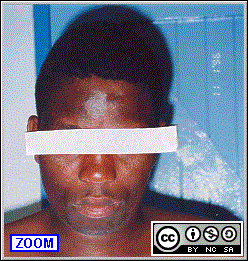 |
| Examination of the neck: |
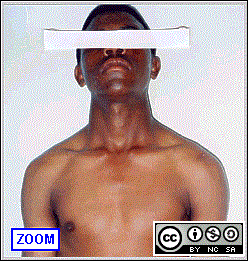 |
| Examination of forearms: |
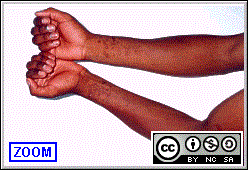 |
| Examination of hands: |
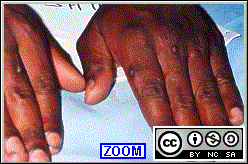 |
| Examination of Nose: |
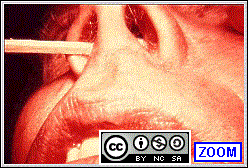 |
Check Schedule 3 of COIDA to make the link. Possible causes of skin ulcers and nasal perforations are arsenic, chrome, nickel.
COMPENSABLE OCCUPATIONAL DISEASES UNDER THE COMPENSATION FOR OCCUPATIONAL INJURIES AND DISEASES ACT (COIDA) SCHEDULE 3
Diseases |
Work Any work involving the handling of or exposure to any of the following: |
| Pneumoconiosis-fibrosis of the parenchyma of the lung (eg. asbestosis, silicosis) | organic or inorganic fibrogenic dust |
| Pleural thickening causing significant impairment of function | asbestos or asbestos dust |
| Mesothelioma of the pleura or other malignancy of the lung | asbestos or asbestos dust |
| Bronchopulmonary disease | metal carbides (hard metals) |
| Byssinosis | flax, cotton or sisal |
| Occupational asthma | the sensitising agents -
(1) isocyanates |
| Extrinsic allergic alveolitis | moulds, fungal spores or any other allergenic proteinaceous material, 2,4 toluene-diisocyanates |
| Malignancy of the lung | coal-tar, pitch, asphalt or bitumen or volatiles thereof |
| Malignancy of the lung | nickel or its compounds |
| Malignancy of the lung | hexavalant chromium compounds, or bis chloromenthyl ether |
| Tuberculosis of the lung | (1) crystalline silica (alpha quartz) (2) mycobacterium tuberculosis or MOTTS (mycobacterium other than tuberculosis) transmitted to an employee during the performance of health care work from a patient suffering from active open tuberculosis |
Diseases |
Work Any work involving the handling of or exposure to any of the following: |
| Allergic or irritant contact dermatitis | dust, liquids or other external agents or factors |
| Malignancy of the skin | coal-tar, pitch, asphalt or bitumen or volatiles thereof |
| Melanoma of the skin | polychlorinated biphenyls |
Diseases |
Work Any work involving the handling of or exposure to any of the following: |
| Hearing impairment | excessive noise |
| Erosion of the tissues of the oral cavity or nasal cavity | irritants, alkalis, acids, or fumes thereof |
| Malignancy of the larynx or mouth cavity | coal-tar, pitch, asphalt or bitumen or volatiles thereof |
| Malignancy of the mucous membrane of the nose or associated air sinuses | nickel or its compounds |
Diseases |
Work Any work involving the handling of or exposure to any of the following: |
| Hand-arm vibration syndrome (Raynaud's phenomenon) | vibrating equipment |
| Any disease due to overstraining of muscular tendonous insertions | repetitive movements |
Diseases |
Work Any work involving the handling of or exposure to any of the following: |
Any disease or pathological manifestations eg.
|
Beryllium, cadmium, phosphorus, chromium, manganese, arsenic, mercury, lead, fluorine, carbon disulphide, cyanide, halogen derivatives of aliphatic or aromatic hydrocarbons, benzene or its homologues, nitro- and amino-derivatives of benzene or its homologues, nitroglycerine or other nitric acid esters, hydrocarbons, trinitrotoluol, alcohols, glycols or ketones, acrylamide, or any compounds of the aforementioned substances |
| Dysbarism, including decompression sickness, barotrauma or osteonecrosis | abnormal atmospheric or water pressure |
| Any disease | ionising radiation from any source |
| Angiosarcoma of the liver | vinyl chloride monomer |
| Malignancy of the bladder | 4-amino-diphenyl, benzidine, beta naphthylamine, 4-nitrodiphenyl |
| Mesothelioma of the peritoneum | asbestos or asbestos dust |
| Leukaemia | Benzene |
| Brucellosis | brucella abortus, suis or mellitensis transmitted through contact with infected animals or their products |
| Anthrax | bacillus anthracis transmitted through contact with infected animals or their products |
| Q-fever | coxiella burneti emanating from infected animals or their products |
| Bovine tuberculosis | mycobacterium bovis transmitted through contact with infected animals or their products |
| Rift Valley Fever | virus transmitted by infected animals or their products |
FIVE STEPS TO FOLLOW ON DIAGNOSING AN OCCUPATIONAL DISEASE:

Postgraduate Diploma in Occupational Health (DOH) - Modules 3: Occupational Medicine & Toxicology (Basic) by Profs Mohamed Jeebhay and Rodney Ehrlich, Health Sciences UCT is licensed under a Creative Commons Attribution-Noncommercial-Share Alike 2.5 South Africa License. Major contributors: Mohamed Jeebhay, Rodney Ehrlich, Jonny Myers, Leslie London, Sophie Kisting, Rajen Naidoo, Saloshni Naidoo. Source available from here. For any updates to the material, or more permissions beyond the scope of this license, please email healthoer@uct.ac.za or visit www.healthedu.uct.ac.za.
Last updated Jan 2007.
Disclaimer note: Some resources and descriptions may be out-dated. For suggested updates and feedback, please contact healthoer@uct.ac.za.